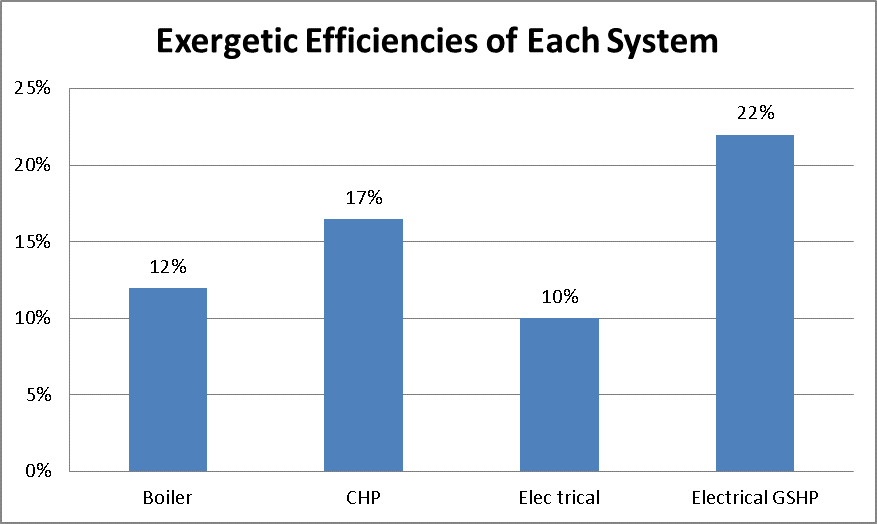Energy Efficiency
We looked closely at the mechanical or electrical efficiency of each potential component of our different district heating systems. By downloading our tool, one can mix and match these different components to create a custom system of your own. For the purposes of our investigation; we agreed on the following configurations for comparison:
- Boiler System
Boiler ⇒ Pipes ⇒ Hot Water Storage Tank at 75degC ⇒ Conventional Radiator - CHP System
Cogeneration Boiler ⇒ Pipes ⇒ Hot Water Storage Tank at 75degC ⇒ Conventional Radiator - Electrical
Grid Electricity(substation) ⇒ Wires ⇒ Storage Heaters
We also investigated electrical systems using GSHP to provide a more efficient alternative to Nines or other electrical based heating.
The method for this analysis is simple, calculating the individual efficiencies for the system components by using typical performance data. We then multiplied these efficiencies together to gain an approximation of the overall system efficiency.
Having finished our analysis, we concluded that the following system efficiencies were common:

Figure 1: Typical energy efficiencies for the investigated systems
It is clear that a modern electrical system are not an appropriate solution for district heating in energy efficiency terms, half as efficient as a centralized boiler system. If one uses ground source heat pumps one will achieve a more competitive, yet still inferior, solution to district heating. However the extra costs and the disruption involved with installation mean that many of the plus points for electrical systems in terms of other criteria within our investigation suffer.
This investigation shows clearly one of the reasons for traditionally limited roll out of electrical heating that is only used in cases where there is little other choice. If one uses old generation electrical heaters or storage heaters that do not involve modern technology the efficiency drops even further.
Exergy Efficiency
Our investigation looks further into the figures mentioned above. By applying the Second Law of Thermodynamics, one can look at the Exergetic Efficiency of a system. This is a measure that examines the irreversibility of a system rather than the inefficiencies. Using datum temperatures to measure the performance of the above mentioned components one can discern the amount of useful energy (or exergy) used out of the potential useful energy available.
Using the same methodology as with energy efficiency to find an approximation of the overall efficiency of a system; we believe that the playing field on which our candidate district heating approaches are assessed levels out considerably.

Figure 2: Typical exergy efficiencies for the investigated systems
One can see that an electrical system with storage heaters suddenly becomes competitive with boilers and CHP. Indeed Ground Source Heat Pump based electrical based systems are more efficient than all the other alternatives in terms of exergy.
Returning to our original inspiration for the project, it would appear that the NINES style modern electrical district heating scheme is inferior in each measure of efficiency and therefore should be treated as such when appraising these systems. However, this does not tell the full story. We argue that if the district heating system were powered by 100% renewable energy, as it is on Shetland, then efficiency matters far less than is does now in electrical heating. Modern heaters can be programmed to only charge when there is an excess of renewable energy available. This energy would otherwise be wasted or sold to a pumped hydro scheme and bought back when need was high. By charging heating for a district one gains a local use for surplus energy that benefits the community. As the UK takes advantage of more and more of it renewable resource, these modern district heating systems will become more and more viable nationwide.
Even when CHP or Boiler schemes are run on biomass, there is still a need to be efficient as one does not want to fell trees at an unsustainable rate for example. Electrical systems do not have this problem if programmed correctly as one is using unwanted, excess energy so efficiency matters far less.
If a battery were used to power a GSHP one could achieve the same effect as with the modern surplus renewables management system. This approach would appear to gain the best of both worlds in terms of efficiency and storing excess renewables.
